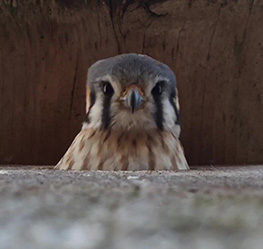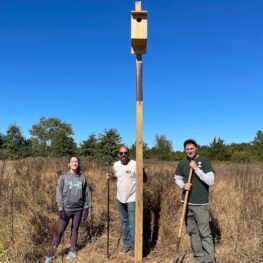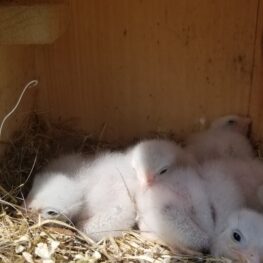Stream Salamander & Fish Surveys
Salamanders and fish are important taxonomic groups in headwater streams, where they play the role of top predators and also prey.
Just as the presence of certain benthic macroinvertebrates is a measure of water and habitat quality, so, too, is salamander and fish presence and abundance. In our region, streams are home to at least 60 species of fish and several salamanders species including the two-lined salamander, northern red salamander, northern dusky salamander, and northern long-tailed salamander, a threatened species in New Jersey.
Raritan Headwaters staff and volunteers will continued surveying salamander populations at our stream monitoring sites already being monitored for “benthic macroinvertebrates,” small creatures that live in river and stream beds. Raritan Headwaters has been using benthic macroinvertebrates living in streams as indicators of water quality since the 1990s.
Vernal Pool Certification
Vernal pools are ephemeral, isolated wetlands without fish living in them. Many are woodland pools but they can also be found in more open habitats such as meadows. Due to the lack of predatory fish, they are breeding hotspots for a host of amphibians, including wood frogs, and spotted, Jefferson and marbled salamanders. They are also used by reptiles, birds, mammals and arthropods.
The first late winter-early spring rains harken the movement of spotted and Jefferson salamanders, wood frogs, toads and a variety of other amphibians from their upland resting places to their breeding wetlands known as vernal pools, where they will lay millions of eggs. These species often suffer high mortality on roads, which they often cross en masse on cold rainy nights as they return to the same pool each year. In some places, the roads are closed on those evenings or volunteers are ready to help amphibians across the road and document their numbers.
Mapping done by the New Jersey Department of Environmental Protection (NJDEP) indicates that there may be at least 461 vernal pools within the North and South Branch Raritan watershed. However, only 121 of them have been confirmed vernal pools based on a list of criteria. Because vernal pools are typically small, most are less than .25 acre, they miss the critical wetland protections afforded wetlands that are greater than or equal to 1 acre.
Raritan Headwaters will continue investigating each potential location – not once, but four times, as required by the NJDEP – to learn what conditions exist throughout the seasons. If vernal pools are found, they have water for at least two months of the year, and are documented as breeding sites for amphibians, they are eligible for special state protections.
Habitat Connectivity
To ensure protection of biodiversity in the upper Raritan River watershed, important wildlife habitats must stay connected.
For example, many salamanders and frogs spend the winter in upland habitats, but migrate to wetlands and vernal pools on lower ground to breed. If their path is blocked by roads, many can be killed or fail to reach their breeding places. In addition, poorly designed or structurally deteriorating culverts, bridges and dams can disrupt the connectivity of streams and prevent movement of fish and other aquatic organisms upstream and downstream.
Since 2018, Raritan Headwaters been participating in the North American Aquatic Connectivity Collaborative (NAACC) and Connecting Habitat Across New Jersey (CHANJ) to assess whether culverts, bridges and other crossings are interfering with movement of aquatic and terrestrial organisms and which are providing important road crossing tunnels for wildlife. The goal is to share these data with municipalities and other partners in order to ensure connections are maintained or restored. In 2021, RHA assessed 150 stream-road crossings in the Upper Raritan for terrestrial and aquatic connectivity on behalf of the NJ Fish and Wildlife, Endangered and Nongame Species Program. Read our August 2022 Final Report.
Kestrels providing the Land-Water connection
Kestrels are ambassadors for the connection between what we do on the land and the health of our water. – Cindy Ehrenclou

Adult male American Kestrel peaking out of a nest box on a partner property. Photo by Bill Pitts.
Meet the American Kestrel, our smallest falcon species. It is one of the most colorful and widespread raptors in North America. Insects as well as small birds and rodents make up their preferred diet. When hunting, they often spend time perched in open areas on telephone wires and fence posts, so you have likely seen one before.
Kestrels were once very common in the Upper Raritan, but over the past 50 years they have become rare as their populations have declined by over 80 percent in the northeastern United States. Kestrels prefer open habitats such as meadows, pastures, agricultural fields, and forest clearings, which are abundant in the Upper Raritan Region of New Jersey. They are cavity-nesters (nest in holes), often in large, isolated trees in open fields. With the advent of “clean” farming practices removal of trees and brush between working fields has become common and with it the loss of preferred nest sites for kestrels. While factors such as loss of habitat, use of pesticides, planting of monocultures of row crops, and competition for nest sites by invasive species (e.g., European Starling) contribute to the decline of kestrels, placing nest boxes throughout our watershed will promote their recovery.

Installing kestrel nest boxes with Somerset County Parks. Left to right, Madison Purguy (RHA Kestrel Intern), Bill Pitts (NJ Fish and Wildlife biologist), and Rob (Somerset County Parks).
Raritan Headwaters Kestrel Partnership – Raritan Headwaters (RHA) initiated the Kestrel Partnership in 2018 to help in the recovery of this threatened species while also imparting best management practices (BMPs) to benefit all wildlife (over 60 species of grassland/meadow birds) while protecting water resources in the Upper Raritan Watershed. In collaboration with NJDEP’s Endangered and Nongame Species Program, RHA is installing and monitoring kestrel nest boxes with partners including land trusts, public land managers, private landowners and farmers. The goals are to increase the kestrel population over time by giving them a head start in finding a place to build their nests and raise young.
How to Get Involved
- Join the Raritan Headwaters Kestrel Partnership: Do you live in the Upper Raritan and have suitable open habitat on your property (meadows, grasslands, agricultural fields) fit for placing a kestrel nest box? Do you want the opportunity to work with RHA and NJ Fish and Wildlife to monitor and band kestrels on your property? Contact us (kmacdonald@raritanheadwaters.org) and learn more about joining the Raritan Headwaters Kestrel Partnership and read this blog from program partner and RHA trustee Deb DeSalvo.
- Install your own Kestrel Nest Box: You do not need to formally join the RH Kestrel Partnership to help in the recovery of this species. Install your own nest box and prep it for nesting season in late March/early April. We can offer advice on placing the box on your property so it is most attractive to kestrels as well as care and maintenance. We have boxes available for you for a suggested donation of $50 (email kmacdonald@raritanheadwaters.org) or you can build your own.
- Report bird sightings on eBird: help track bird populations and habitat use as well as the value of preserving open space for birds and other wildlife on your property and when visiting public open space.
- Build a Meadow or warm-season grassland: Allowing all or part of your property to revert to native wildflowers and warm-season grasses has many benefits to wildlife, water quality, decreased maintenance, and visual appeal. Kestrels need open habitats such as these in which to nest and hunt. A resource on transforming turf to meadow and grassland can be found here.
- Implement Best Management Practices (BMPs) for Farms and Fields: here
- Become a Backyard Steward: Every backyard counts toward protecting wildlife, land and water resources. Learn more about what you can do and how to become a Backyard Steward. Additional details on enhancing habitat for wildlife can also be found here.
- Volunteer: We are looking for volunteers to help with the RH Kestrel Partnership. Would you like to help monitor kestrel nest boxes? Are you a Girl Scout or Boy Scout interested in helping to build boxes and put boxes up on open space? If you are interested in volunteering, contact Debbie Newcomb, RHA Volunteer Coordinator, dnewcomb@raritanheadwaters.org or fill out a volunteer application.
- Preserve Land: Use our guide here to learn the many ways to protect and preserve open space.
- Donate to support the Raritan Headwaters Kestrel Partnership and other projects to protect the Upper Raritan Watershed Region.

Hope for the future of the American Kestrel – Recently hatched kestrels in a nest box at RHA’s Fox Hill Preserve in Tewksbury, NJ. Photo by Bill Pitts.
To learn more about the Raritan Headwaters Kestrel Partnership, contact Kristi MacDonald, Ph.D., Director of Science at kmacdonald@raritanheadwaters.org.
This project is funded through a grant from The Cornell Lab of Ornithology and support from members of Raritan Headwaters and partners including NJ Fish and Wildlife Endangered and Nongame Species Program, The Raptor Trust, The Peregrine Fund, Duke Farms, Tewksbury Land Trust, New Jersey Conservation Foundation, North Jersey RC&D, Somerset County Parks, Morris County Parks, Bluebird Alpaca Farm, Flipside Farm CSA, and the Township of Bedminster, NJ.
Top photo of an American Kestrel bringing prey to its young at Fox Hill Preserve by Dallas Hetherington.



